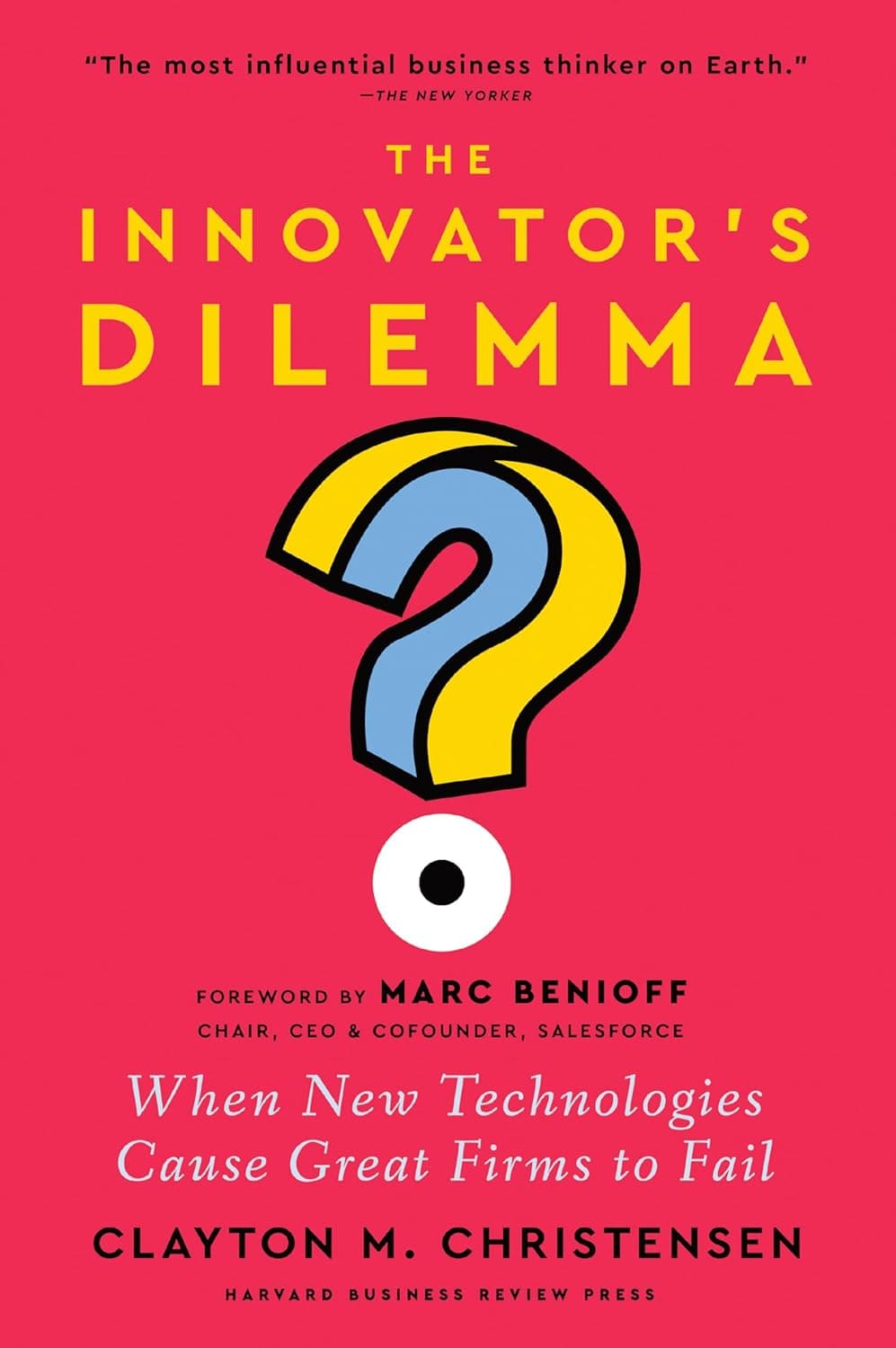The Innovator's Dilemma

GET THE #1 EMAIL FOR EXECUTIVES
Subscribe to get the weekly email newsletter loved by 1000+ executives. It's FREE!

Jeff Bezos cites The Innovator's Dilemma as one of the most important books he's ever read. He talked about how it was foundational to his thinking and the development of the Kindle.
The Innovator's Dilemma
The concept of The Innovator's Dilemma, coined by Clayton Christensen, describes a paradox where successful companies fail not because of poor management but precisely due to good management.
Here's a quote from the book:

These companies do everything right—they listen to customers, invest in new technologies, and focus on profitable growth—yet still lose market leadership when faced with disruptive innovation.
Great. I know. Just another thing for you to watch out for. Not only do you have to worry about competitors, a recession, working from home, and the price of hot chocolate in town, but now you have to worry about being too good at what you do.
Classic.
Meanwhile Mark Zuckerberg is spending 10 billion a year building the Metaverse, a virtual world with 4 users and strange avatars that have no legs.

Anyway this article is the innovators dilemma and not the billionaire's dilemma so let's get back to it.
The Core Paradox
Here's the crucial insight: The very things that make a company successful in the present can make them vulnerable to disruption in the future.
I'm writing this article now, because the author talks about how this is particularly important when a company is presented with a disruptive technology.
And our little friend AI is a disruptive technology.
So How Does This Happen?
Existing companies are good at process, execution and efficiency. For the most part, businesses grow by getting good at what they do. They listen to customers, invest in new technologies, and focus on profitable growth.
- Established companies focus on existing customers
- They improve their products based on customer feedback.
- They invest in innovations that current customers want.
- They maintain high profit margins on current products.
The problem is that these same practices can blind companies to new opportunities. Disruptive innovations often come from the low end of the market, serving customers that existing companies ignore.
- Disruptive innovations initially appear inferior
- They often perform worse on traditional metrics.
- They serve a smaller, less profitable market.
- They have lower margins and seem less attractive.
As a result, it is entirely rational for established companies to ignore disruptive innovations. They don't make sense in the context of the company's existing business model.
Just think if you pivoted your whole business every time a new technology came out. You'd be pivoting every 5 minutes.
Ugh and then you would currently have some strange blockchain division that no one uses.
The Netflix Example
Netflix's early story perfectly illustrates how to overcome the innovator's dilemma:
-
Traditional Business (97% of Revenue)
- Selling DVDs
- Established customer base
- Immediate profitability
-
Disruptive Innovation (3% of Revenue)
- DVD rental by mail
- Small customer base
- High customer acquisition costs ($300 per customer)
- Initially unprofitable
Most companies would have stuck with the profitable DVD sales business. Instead, Netflix made the counterintuitive choice to focus on rentals, setting the stage for their eventual transition to streaming.
This decision was insanely risky, they bet the house on 3% of their revenue! Not only did they focus on it, but they literally stopped focusing on their main business.
Why Good Companies Fail
The innovator's dilemma explains why industry leaders often fail when disruptive technologies emerge. Consider these historical examples:
-
Kodak
- Invented digital photography in 1975.
- Shelved it to protect their film business.
- Filed for bankruptcy in 2012.
-
Blockbuster
- Had the opportunity to buy Netflix for $50 million. Currently worth $321 billion.
- Focused on their profitable store model.
- Filed for bankruptcy in 2010.
-
Nokia
- Dominated mobile phones in the 2000s.
- Missed the smartphone revolution.
- Sold their phone business to Microsoft in 2013.
The Five Principles of the Innovator's Dilemma
-
Companies depend on customers and investors for resources
- This creates a dependency on existing business models.
- Makes it hard to invest in disruptive technologies.
-
Small markets don't solve the growth needs of large companies
- A $1 million opportunity excites a startup.
- The same opportunity is irrelevant to a billion-dollar company.
-
Markets that don't exist can't be analysed
- Traditional market research doesn't work for disruptive innovations.
- Requires faith and experimentation.
-
An organisation's capabilities define its disabilities
- Processes that make a company efficient in one context becomes a handicap in a disruptive context.
-
Technology supply may not equal market demand
- Technology often progresses faster than market needs.
- Creates opportunities for disruptive innovations.
This last point is really important. Currently we are witnessing this with the AI boom.
It seems that every week, the labs are bubbling up some new model that can do something amazing and it's certainly progressing faster than the market can absorb it.
Once the market does absorb it though, I really hope Sharepoint is the first thing to go. You have groups and Teams and Onedrive and Sharepoint and it's all a mess and surely an AI can sort that out.
Alright, you are an A student, sitting their listneing to your customers, with a very efficient business, but you are going to go bankrupt, what do you do?
How to Overcome the Innovator's Dilemma
-
Set up an independent organisation or team within the business
- Create separate units for disruptive innovations.
- Give them different metrics for success.
- Allow them to develop their own culture.
Note he does have a matrix in the book that shows how to do this. Essentially the further the technology is away from the core business, the more independent it should be.
If you are a small business, don't set up a separate unit, just focus on the new technology.
As Dave Limp from Amazon said:

- Accept failure as part of innovation
- Plan for multiple iterations.
- Learn from small-scale experiments.
- Don't expect immediate profitability.
This mindset is critical, because disruptive innovations often fail to meet traditional metrics. They require time and patience to develop.
Jeff Bezos gets 100 points for Gryffindor for this. He has a whole section in his shareholder letters about how they are going to fail and how they are going to learn from it.
When one of his team members lost money he would say:

After that he would say:
Figure out and clearly document where you went wrong. Share what you have learned with other leaders throughout the company. Be sure you don't make the same mistake again, and help others avoid making it the first time."
- Find appropriate customers
- Look for early adopters who accept lower performance.
- Focus on new markets rather than existing ones.
- Build a customer base that can grow with the technology.
Remember you are in startup land now, so borrow the playbook from a startup and build something that people love.
- Start small and iterate
- Begin with minimal viable products.
- Improve based on real market feedback.
- Scale only when the model is proven.
Conclusion
Interestingly Amazon, Apple, Netflix and Google have all mentioned the Innovator's Dilemma as informing their thinking.
There is a reason that this wave of companies did not go the same way as Kodak and Blockbuster.
They were able to overcome the innovator's dilemma by setting up separate units, accepting failure, finding appropriate customers and starting small.
Sure you might laugh at the Metaverse or the crazy glasses that Zuckerberg is wearing, but this is all part of the process of Meta trying to build a new technology that could disrupt the current one.

















